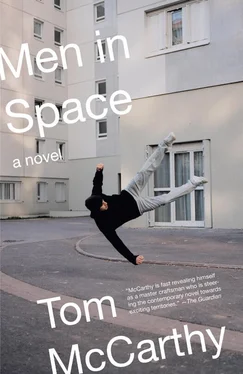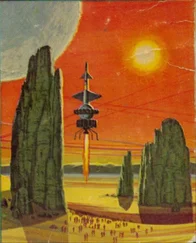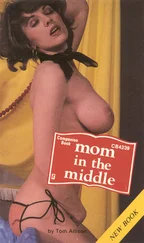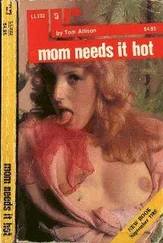“A veritable pleasure.” Ivan shakes both their hands. The one with brown hair must be Nick. Ivan brings the block-wood panels over to the table.
“You only need to prime one up,” Klára tells him.
“No,” replies Ivan, looking down now. “I think I’ll do them both. You never know.”
She turns to the brown-haired young man and asks:
“This Bulgarian’s a friend of yours?”
“Anton? Yeah. He was my neighbour when I lived in Vinohrady. He used to be a football referee, and now he’s a political refugee. I’m Nick. You’ve got a piece of gold leaf in your hair.”
He picks it out for her. The American girl walks off into the bathroom.
“Hey, Ivan, do you remember when that Polish girl was round here and I thought she’d got a charcoal smudge across her face and it turned out it was a birthmark?” Nick says, letting the gold leaf flutter to the ground.
“I certainly do. You entirely spoiled my chances of seduction with her.”
“I’ve got to go now,” Klárá says to Ivan, in Czech.
“If you want to be helpful,” she hears Ivan tell Nick as she walks into the bedroom and puts on her shoes, “you might complete the joint I was constructing. I find it concentrates my mind, and I have work to undertake.”
The American girl’s voice comes from the bathroom:
“There’s a condom in here!”
* * * * *
… with the result that I am becoming something of an expert on the subject of zography. Most of my knowledge is gleaned from telephone conversations between Ivan Maňásek and Klárá Jelínková, which have been occurring on an almost daily basis. Over the course of these, she has informed him that the image he is copying most probably stems from a set of murals in Bačkovo, a Bulgarian monastery founded in roughly 1100 [eleven hundred]; that, since at this time Bulgaria was ruled by Byzantium, the monastery was in what she termed “deep bandit country”; and that the monastery’s muralists were trained in Byzantium then sent back to Bačkovo to paint in the official style, this style being an extension of religious dogma, a putting-into-action of Byzantium’s edicts. For example: Byzantium might decree that, when painting ascensions (as Maňásek is currently), the Coptic-Egyptian code, which depicts the body rising intact to heaven, must be followed; but at a later date, Byzantine doctrine might change to decree that the Palestinian code, whereby the soul departs the body — represented by, for instance, a dove — must be observed. A painter could be imprisoned or even executed for using the wrong code at the wrong time.
On learning these facts, Maňásek ventured that Byzantium during this period acted much as Moscow has done during most of ours. I must admit that I find his reasoning sound — indeed, compelling. In prohibiting modes of expression not sanctioned by Moscow and in supervising and arresting dissidents such as Maňásek for deploying such modes, was our state not performing a similar role to that of the regional enforcers of Byzantium’s canons? The Emperor Comnenus, Domesticus of the Western Byzantine army, Jelínková informed Maňásek during their second or third phone conversation, realizing he could not crush dissidence entirely, took to hiring Georgians and Armenians as priests — people who, being closer to the Bulgarian natives, gave an impression of independence. Comnenus thought, not unreasonably, that by being a little laxer in Bulgaria than he was back in the seat of Empire, he would manage simultaneously to monitor and absorb the energy that might have undermined Byzantine doctrine, to channel it through an official institution: Bačkovo would thus serve as (as it were) both loudspeaker and listening device. But, she continued, as time progressed the muralists started taking more liberties than Comnenus had intended, flouting the canons with heretical paintings, and the regime of propaganda and surveillance envisioned by the Domesticus slowly broke down. Was this not the fate, after Perestroika , of the empire of which our nation formed a part?
Maňásek and Jelínková talk; I listen and repeat; and my superiors listen in through me. My car is cold, but I am loath to leave the engine running for extended periods lest I draw undue attention to my presence. Most of the time Maňásek works silently: I hear him moving around his studio as he copies the painting — the odd scrape or rustle, but no more. He seems unwilling to receive visitors. His flatmate has been absent for the last 3 [three] days. The most recent phone call between Maňásek and Jelínková took place at 17:42 [seventeen forty-two] on December 24th [twenty-fourth]. On this occasion he did have a visitor, with whom he conversed in English while speaking in Czech to both Jelínková and, for much of the time, his landlady, who had come onto the building’s party phone line. During the course of this call, he informed Jelínková that he was making 2 [two] copies of the painting, and would give the best one of these to Associate Markov. Jelínková seemed flustered, and kept trying to tell Maňásek about an unknown saint she had discovered among the ones depicted in the Bačkovo murals. Maňásek, meanwhile, argued with his landlady, who repeatedly requested that he leave the line to her since she needed to phone her sister who had been ill for a week, and reminded him that he had not paid the last month’s rent. He informed her he would pay the rent if she hung up her own phone, adding that if her sister had been ill for a whole week she was unlikely to die within the next few minutes, and joking in English with his unknown visitor that party lines owe their name to the fact that there’s always a party going on on them — a point with which I must, again, concur.
The tone of Jelínková’s voice suggested that the information she was trying to impart was vital; she seemed quite disturbed by it. This unknown saint, she kept trying to tell him, was not one recognized within the standard canon, and was not even Christian in origin. Scholars seemed to agree that his provenance was Greek: eastern Greek, either Lydian or Phrygian. After his first appearance in Bačkovo, Jelínková said, his image cropped up, albeit extremely rarely, in the work of several painters, the most prominent of whom were the Zaharievs, a family of zographs operating in the last century. He was, she continued, always shown ascending, just like Christian saints — yet, not being Christian, there was no particular reason why he should be doing so. Despite the imagery in which, for the sake of convenience, it cloaked itself, his presence served another purpose, embodying other beliefs and sets of knowledge — values perhaps long since defunct but which, through him, had found their way into the zographic repertoire. This is the information to which Jelínková attached so much importance, and by which she seemed disturbed.
Maňásek broke off arguing with his landlady and quipping with his unknown guest to ask Jelínková if she believed that the artwork he was currently copying depicted this same maverick saint. Jelínková replied that she thought it possibly did, and that his painting might be by a Zahariev, since these were the only nineteenth-century zographs in whose work the saint was known to have appeared — adding that if this were the case, the painting was extremely valuable. She expressed doubts as to the honesty of Associate Markov and the legality of his activities. Maňásek seemed unconcerned by her anxieties, and resumed goading his landlady, enquiring whether her sister was attractive and implying that prior to 1989 [nineteen eighty-nine] she (the landlady) had passed on information about him to the STB — a claim that, while made maliciously and without any basis in evidence, was, as my team had already established while attempting to recover details of previous surveillances of Maňásek, true.
Читать дальше












